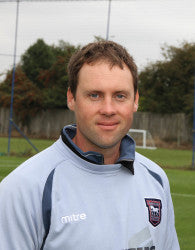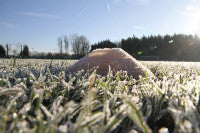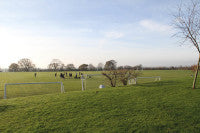Training Grounds for improvement

Having come from a non-footballing background - Ben Connell was previously Head Groundsman at St Joseph's College - our editor, Laurence Gale, suggested that it might be a good idea for him to visit the training grounds of a few other clubs to get a feel for what they were providing. And, so, in late November, he accompanied Ben to two Championship sides - Wolves and Derby - and the Premier League's Stoke City and Manchester City, the latter of whom have impressive plans in place to provide a new, state-of-the-art complex alongside the Etihad stadium.
Many of the top flight clubs have invested heavily in their training facilities in recent years, amongst them Stoke City, Chelsea, Arsenal, Spurs and Manchester United.

The EPPP is a youth development scheme initiated by The Premier League. Its intention is to free up movement of younger players by establishing a hierarchy of association football academies in England and fixing the transfer fees between academies.
The Premier League published the following list of principles upon which the EPPP was designed after its ratification by the members of the Football League:

- Improve coaching provision
- Create more time for players to play and be coached
- Implement a system of effective measurement and quality assurance
- Positively influence strategic investment into the academy system, demonstrating value for money
- Seek to implement significant gains in every aspect of player development
The plan aims to improve youth development by focusing on the following:
- Allowing clubs to have more coaching time with their young players
- Helping clubs foster links with local schools in order to help young players get the best out of their football education as well as the academic side
- Allowing clubs that have earned a top category grading to recruit young talent from further afield than is permitted under the current rules
- Working with the Football League to review the current system used for determining compensation
Manchester City's ambitious project, dubbed the Etihad Campus, was recently unveiled. The state-of-the-art complex, which will include the main stadium and SportCity complex, has been two years in the planning and is unprecedented in scale. The new facilities, to be built on eighty acres of land owned by the football club in Openshaw West, include sixteen pitches - four for the first team, including one indoor artificial full-size pitch, and twelve for academy players.

The cutting edge training facilities will massively boost the club's capacity to nurture local talent, with space for four hundred young players, and with a significant focus on developing home-grown stars.
However, for now, the club's Carrington training ground remains their focus, and it was here that Ben and Laurence first went, to meet Head Groundsman, Lee Metcalfe. Ben takes up the story.
"Ipswich Town has fallen behind in recent years, with little additional development of the training ground since it first opened in 2000. This is mainly due to being relegated from the Premiership in 2002. With the club cutting their cloth accordingly, a return to the Premier League is the most likely time for investment into our facilities. Although this looks unlikely this season, there is no harm in being prepared!
During my training grounds tour, I had a hit list of areas I was wanting to look at; training centre layout, backstop netting, portable and statics goals, banks of pitches, budgets, feeding programmes, staffing levels, working hours, rotas, machinery, what methods were being used on the pitches for tidying up after training, how frost was dealt with, whether renovations were carried out in-house or by contractors and what the budget for these were and, finally, the general expectations from the club of their groundstaff. Phew!
The Midlands seemed a good base to work from, with a number of clubs in reasonably close proximity. I particularly wanted to look at clubs in a similar situation to ourselves, plus ones that had progressed when finances had become available.

On the day of our visit, it was a frosty morning but, with the undersoil heating turned on, the ground wasn't frozen and there was only a leaf frost to contend with. Once the players had come out at 11.00am, most of the frost had gone, with the last areas being knocked off with a short cycle of the infield irrigation. At Ipswich, we would have been lugging frost covers off in the morning and then back on after training if cold temperatures were due the next day.

I was interested to see the biostimulants and a potassium liquid fertilisers which Lee was applying to his pitches. he was getting very positive results. These were applied all year round on a monthly bases. Lee had commented that he could see a big visual effect within twenty-four hours.

Next, it was on to the Britannia Stadium to meet Andy Jackson. Promotion four years ago sees Stoke City in a different financial position to Ipswich, although Andy's budgets and staff levels aren't dissimilar.

I am going to recommend having primary drainage installed at our training centre. This year, we have seen extremely high rainfall recorded, coupled with an additional six hundred hours of training due to the revised EPPP category two status. I need to ensure that the rain is being dealt with efficiently, so that training isn't taking place in wet conditions, leading to damage to the surface and long term damage to soil structures, which lead to more problems in the future.

Although we have a couple of homemade lighting rigs for the goalmouths, I believe it is essential for us to invest in larger rigs, as I saw at Stoke, to aid recovery from games and keep the turf as healthy as possible during the tough winter period of low light levels. The west wing at Portman Road struggles when the sun doesn't manage to get above the stands. Our south stand has a perspex roof with the belief that it will allow light to penetrate to the pitch. It has just had its first clean in twelve years, so I will be observing to see the benefits!

I was interested to see that Derby have the same issues with the amount of academy football and excessive use on the floodlit areas in the evenings.
We arrived at the training ground at 9.30am to be met by the club's Head Groundsman, Andy Croft, and his assistant Paul Sheppard who, again, were waiting for the early morning frost to clear, ready for the first team training sessions to begin under the watchful eye of the club's manager, Nigel Clough.

Last year, Andy worked closely with Paul Moreton, Technical Sales Representative for British Seed Houses, to trial an adapted A20 seed mixture aimed at giving sustained groundcover and cold tolerance to see him through the winter months, especially on the exposed site where temperatures can be four or five degrees cooler than in the stadium.
Andy explained that the pitches had been koroed and seeded from scratch, and that the results had been very good, with the plant proving very hardy, and exhibiting that comforting trait of rebounding instantly after being stood on, which is a sign of a healthy, stiffened leaf blade.

At Ipswich, we have our own renovation equipment, and spend a long summer carrying out renovations on all our thirteen pitches. Derby have a similar area, but have just spent more than double what we spend on renovations by having contractors carrying out the work.
Finally, Laurence and I made our way south to Wolverhampton Wanderers' Compton training ground just a few miles away from their Molineux stadium.
We arrived just in time to catch some lunch in the players canteen, before making our way out onto the training ground which, in recent years, has seen a lot of investment, especially during their time in the Premiership.

The training ground is set out on two tiers, providing several full size pitches and a number of small areas for drills and rehabilitation work. There are two full size pitches on the lower tier with one mirroring the Fibrelastic pitch at the stadium, now complete with undersoil heating to help ensure that no training sessions are lost.
Prior to having the undersoil heating system installed, the groundstaff were using frost covers to protect the pitch, much like we still do at Ipswich. However, when temperatures get to minus 4OC over consecutive days, it often leaves the ground unplayable, so the players then head down to the stadium to train, adding more wear. Since the system has been employed, no training takes place at Molineux.

There is a significant investment in football sundries such as goalposts, ball stop netting and coaching equipment.
However, the key to success is the ability to get on with the job in hand and have the resources to deliver quality playing surfaces.
Wolves' training ground is going through a transformation, much in the way I'd like ours to be developed at Ipswich. Artificial turf training areas and a Fibrelastic pitch with undersoil heating for the first team would be high on my recommendations. I'd also like to see an open plan layout, so that mowing could be simplified whilst also saving valuable time.

We popped across to Molineux to hear and see how well the Fibrelastic pitch was bearing up to the rigours of Championship football. Wayne said that he is very pleased with its performance, especially as he only has two small lighting rigs to encourage growth. His philosophy of doing what is right for the grass plant at the right time, along with a little and often approach when using any products and cultural practices, appears to be working well for him.
I came away from our whistle-stop tour with a much better understanding of what will be required at Ipswich. I'd like to thank all of my colleagues for allowing me the time to visit their sites and, of course. Laurence for setting up all the visits and accompanying me on my tour. Now, I've got to sit down and write my own recommendations to present to the Ipswich management!"

First team pitch
Construction - sand rootzone
Irrigation - Rainbird 8005 pop-ups - 16 heads.
Secondary drainage installed
This was achieved by sand slitting with the AFT whizz wheel at transverse directions to the lateral drains, to a depth of 450mm, to link in with the lateral drain. When this was completed, the pitch was fraise mown with four passes to remove the existing vegetation, verti-drained to a depth of 10 inches and topdressed with MM55 sand, then dragmatted. Once the sand had been worked into the holes, the pitch was overseeded in four directions with a British Seed Houses A20 bespoke mix.
Match pitch
Construction - sand rootzone
Irrigation - Rainbird 8005 pop-ups - 16 heads.
This pitch was fraise mown with four passes, verti-drained to a depth of 10 inches, topdressed with 60 tonnes of mm55 then dragmatted in. When the topdressing was worked into the holes, it was overseeded with twenty bags of A20 bespoke mix and 250kg of Everris 8:12:8 pre-seeder was applied.
All other first team pitches
Construction - sand rootzone
Irrigation - Rainbird 8005 pop-ups - 32 heads.
Each pitch was fraise mown with four passes, verti-drained to a depth of 10 inches then each pitch was top-dressed with 60 tonnes of MM55 sand. The sand was then worked into the holes and each pitch was seeded with twenty bags of A20 bespoke mix. Each pitch was then fertilised with 250kg of Everris 8:12:8 pre-seeder.
Academy pitches
Construction - clay base
2 x full size pitches - 11- x 72 yards
1 x small sized pitch - 60 x 40 yards
During the close season these pitches had a total of 45 Rainbird 8005 pop-up sprinklers installed, both around the perimeter and also inside the pitches. This is the first time these pitches have had proper irrigation. In previous years, we have had to rely on a Speedy Rain travelling sprinkler to irrigate, which meant we could not properly renovate with a fraise mow or Koro so, as soon as the irrigation was installed, we renovated as follows:
All pitches were fraise mown in four passes, verti-drained to a depth of 10 inches and topdressed with 150 tonnes of MM55 sand The whole area was then dragmatted before overseeding with forty-five bags of A30 renovator mix and fertilised with 625kg of Everris 8:12:8 pre-seeder.
Academy pitches for under 9/10s
Construction - clay base
2 x small sized pitch - 60 x 40 yards
These pitches also did not have irrigation and relied on the traveller to water them. So, in the close season they both had twelve Rainbird 8005 sprinklers installed; six in each pitch. No proper renovation had previously been possible as these pitches did not drain away very quickly. So, when the sprinkler system was installed, the pitches were renovated as follows:
Secondary drainage installed. This was achieved by sand slitting to a depth of 250mm at transverse directions to the lateral drains, backfilled with gravel, and then sand. They were then fraise mown in four passes to achieve a clean surface, vertidrained to a depth of 10 inches, topdressed with 20 tonnes on each pitch, dragmatted in to the holes, seeded with ten bags each of A30 renovator mix, then fertilised with 125kg of Everris 8:12:8 pre-seeder.
All pitch renovation work was carried out by Talbot Landscapes.
All irrigation work was undertaken by Osprey Irrigation using Rainbird sprinklers.
Sand supplied by Mansfield Sand.
Seed supplied by British Seed Houses.
